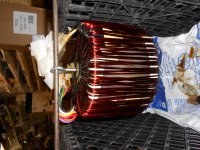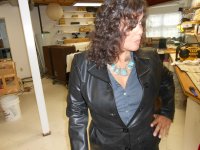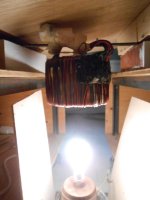Hi djk;
Too late for hot spot checking, its in the drink. But you bring up a great point. The amps draws 3 amps at idle (bit of a power pig, IMHO). My variac rig has a 1 amp AC meter. If the Toroid had a shorted turn, would this not cause a high current draw if I power up the tranny, outside of the amp?
Too late for hot spot checking, its in the drink. But you bring up a great point. The amps draws 3 amps at idle (bit of a power pig, IMHO). My variac rig has a 1 amp AC meter. If the Toroid had a shorted turn, would this not cause a high current draw if I power up the tranny, outside of the amp?
I'm not sure what the idle current should be.
I had once had a toroid with a shorted turn, a local hot spot, and a buzz. I don't remember what the current draw on it was. I can tell you that I was testing with high line voltage when it developed the buzz, and when the voltage was lowered to nominal (after a fraction of a second) it was ruined.
I had once had a toroid with a shorted turn, a local hot spot, and a buzz. I don't remember what the current draw on it was. I can tell you that I was testing with high line voltage when it developed the buzz, and when the voltage was lowered to nominal (after a fraction of a second) it was ruined.
Hi djk;
Too late for hot spot checking, its in the drink. But you bring up a great point. The amps draws 3 amps at idle (bit of a power pig, IMHO). My variac rig has a 1 amp AC meter. If the Toroid had a shorted turn, would this not cause a high current draw if I power up the tranny, outside of the amp?
that does sound really high for magnetizing current for a toroid, it should be a fraction of an EI core for an equivalent VA level. I reckon ~3% of I at rated power, and an EI would be double or triple that. if you make a plot of magnetizing current as increasing voltage it should be linear until saturation approaches. or one easy way to determine it. It's a short cut to save copper E.g. run the iron core harder!!! in those cases the laminations can be the noise makers.
Last edited:
It will not be linear................ if you make a plot of magnetizing current as increasing voltage it should be linear until saturation approaches. ............
It is an S shape.
Hi djk;
Too late for hot spot checking, its in the drink. But you bring up a great point. The amps draws 3 amps at idle (bit of a power pig, IMHO). My variac rig has a 1 amp AC meter. If the Toroid had a shorted turn, would this not cause a high current draw if I power up the tranny, outside of the amp?
Once you get it out of the drink check the magnetization current. It will more than likely be low - a shorted turn will cause it to draw a whole lot more than 3 amps. Those amps are power pigs - a couple amps at idle is normal.
3A at idle is completely wrong.
Either the core is severely saturating or there are some turns shorting/breaking down insulation. IIRC on a big (1-2 kVA) high quality torroid, Im is in the low 10's of mA.
Now for a dumb question. You have not inadvertently connected your earth to the central mounting bolt of the transformer have you?
If so, that's a shorter turn and you'd be getting the kind of problems you are seeing.
Either the core is severely saturating or there are some turns shorting/breaking down insulation. IIRC on a big (1-2 kVA) high quality torroid, Im is in the low 10's of mA.
Now for a dumb question. You have not inadvertently connected your earth to the central mounting bolt of the transformer have you?
If so, that's a shorter turn and you'd be getting the kind of problems you are seeing.
Your test of removing the transformer and powering it was a good idea.
The transformer is made from slit steel and wrapped like a doughnut, The first turn is usually spot welled and then continue winding the steel. when finished the outer turn end is again then spot welled. Good cores are then dipped in an epoxy resin.
I think that you have a bad core build as the wires are usually tightly wound.
Your plan about the varnish is a good, In mfg they vacuum impregnate and bake dry.
DO NOT TRY TO BAKE IT IN YOUR OVEN. Out gasses may cause you harm or fire.
Good luck Duke
The transformer is made from slit steel and wrapped like a doughnut, The first turn is usually spot welled and then continue winding the steel. when finished the outer turn end is again then spot welled. Good cores are then dipped in an epoxy resin.
I think that you have a bad core build as the wires are usually tightly wound.
Your plan about the varnish is a good, In mfg they vacuum impregnate and bake dry.
DO NOT TRY TO BAKE IT IN YOUR OVEN. Out gasses may cause you harm or fire.
Good luck Duke
Hi guys;
The 3 amp idle current is what the Crest manual claims. I will measure the no load current when I have finished my varnish dipping, before I reinstall it (secondaries open).
Bonsai; the specs also claim a max 36 amps input, when the amp is driving 4 ohms, bridged, (5000 Watts). There are 3 power supplies for the class H rails, and a separate secondary winding for the fans. This is MONSTER Amp, compared to anything else I have owned and am determined to make it behave in my home theatre.
Pictured is the toroid after the first dip. It soaked for 20 hours, After removing, it dripped for about 8 hours. I suspect that internal cavities filled and then drained. I will keep repeating this process until I am convinced that it is a solid block of varnish.
The 3 amp idle current is what the Crest manual claims. I will measure the no load current when I have finished my varnish dipping, before I reinstall it (secondaries open).
Bonsai; the specs also claim a max 36 amps input, when the amp is driving 4 ohms, bridged, (5000 Watts). There are 3 power supplies for the class H rails, and a separate secondary winding for the fans. This is MONSTER Amp, compared to anything else I have owned and am determined to make it behave in my home theatre.
Pictured is the toroid after the first dip. It soaked for 20 hours, After removing, it dripped for about 8 hours. I suspect that internal cavities filled and then drained. I will keep repeating this process until I am convinced that it is a solid block of varnish.
Attachments
Hi Duke;
Rest assured that I will not put the toroid in the oven. My biggest concern is damage to all the connectors. Pictured is my wife, quite 'ticked off' that I was using her hair dryer. I don't want to think about what she would do if she found it in the oven...
Rest assured that I will not put the toroid in the oven. My biggest concern is damage to all the connectors. Pictured is my wife, quite 'ticked off' that I was using her hair dryer. I don't want to think about what she would do if she found it in the oven...
Attachments
She's probably not happy you brought that damn thing home in the first place. And continuing to tinker with it.
Oh, I get it now - she was the one upset about the amp humming in the first place, right?
Oh, I get it now - she was the one upset about the amp humming in the first place, right?
Hi Guys;
This is not the first time I've been accused of 'fixing something when it ain't broke'.
While watching the paint dry, I have googled a lot about transformer varnishing. My toroid actually dripped for 24 hours, although the outside was fairly dry in 4 hours. Elsewhere, someone mentioned that the inside would remain a 'gooey mess' and lead to trouble down the road. If the varnish is 'air dry', it needs air to dry. I believe, because of the dripping, there are obviously air pockets again.
It was mentioned here that the first dip is the most important, so I am going to wait 5 more days before dipping a second time.
BTW djk, what do you use your over for? I have my tranny hanging over a 100 Watt bulb, I figured it can't hurt?
This is not the first time I've been accused of 'fixing something when it ain't broke'.
While watching the paint dry, I have googled a lot about transformer varnishing. My toroid actually dripped for 24 hours, although the outside was fairly dry in 4 hours. Elsewhere, someone mentioned that the inside would remain a 'gooey mess' and lead to trouble down the road. If the varnish is 'air dry', it needs air to dry. I believe, because of the dripping, there are obviously air pockets again.
It was mentioned here that the first dip is the most important, so I am going to wait 5 more days before dipping a second time.
BTW djk, what do you use your over for? I have my tranny hanging over a 100 Watt bulb, I figured it can't hurt?
Attachments
...My toroid actually dripped for 24 hours, although the outside was fairly dry in 4 hours. Elsewhere, someone mentioned that the inside would remain a 'gooey mess' and lead to trouble down the road. If the varnish is 'air dry', it needs air to dry. I believe, because of the dripping, there are obviously air pockets...
Yeah, that's why I wrote previously that varnish was not a practical solution and recommended solvent-less epoxy.
I don't mention this just to rub it in, but because I think it's still the best solution.
Let the transformer drip and wait 'til it's dry.
Buy low viscosity solvent-less epoxy with a cure temperature that's within the temperature tolerance of your transformer, say <100 C.
Warm the transformer to less than 100 C but more than room temperature.
Place in the mixed epoxy.
The warm transformer will help the epoxy to flow into the air spaces and then help to cure it so the inside will be jellied before the outside.
Pull it out once the epoxy starts to thicken.
Alternatively you could make a mould for the epoxy and just let the whole lump set.
Best of all would be a mu-metal can that would act as an extra shield.
Or at least a steel can that you could claim is an extra shield😉.
Best wishes
David
Varnish is the wrong material to use.
Varnish "dries" when the solvent evaporates. That reduces the volume left behind and must leave gaps even if nothing dripped out.
The impregnating resin "cures" when the correct heat is applied. It does not dry.
I guess that means the resin does not change in volume.
But either material will find it virtually impossible to pass through/around the layers of insulation between the various windings.
Passing the submerged transformer through repeated heating & cooling cycles will allow the trapped air to expand and then contract. The contraction will try to suck in the surrounding liquid, but I don't hold out much hope for a significant volume to pass to the inner windings.
Varnish "dries" when the solvent evaporates. That reduces the volume left behind and must leave gaps even if nothing dripped out.
The impregnating resin "cures" when the correct heat is applied. It does not dry.
I guess that means the resin does not change in volume.
But either material will find it virtually impossible to pass through/around the layers of insulation between the various windings.
Passing the submerged transformer through repeated heating & cooling cycles will allow the trapped air to expand and then contract. The contraction will try to suck in the surrounding liquid, but I don't hold out much hope for a significant volume to pass to the inner windings.
Last edited:
"Bonsai; the specs also claim a max 36 amps input, when the amp is driving 4 ohms, bridged, (5000 Watts). There are 3 power supplies for the class H rails, and a separate secondary winding for the fans. This is MONSTER Amp, compared to anything else I have owned and am determined to make it behave in my home theatre. "
ok - I got confused - I thought this was the no-load current you were quoting.
ok - I got confused - I thought this was the no-load current you were quoting.
3 amps no load - which is still pretty high. It has a lot of support circuitry in it which is on all the time. Class H also requires power for the step circuits - they are not free even though it reduces average current draw when cranking.
This thing can and will actually draw more than any 36A. 36A is "rated" current at 1/3 power pink noise (1700 watts average). If you have a big enough 4 ohm dummy load, see what it will draw with a sine wave. It's closer to 90 amps.
This thing can and will actually draw more than any 36A. 36A is "rated" current at 1/3 power pink noise (1700 watts average). If you have a big enough 4 ohm dummy load, see what it will draw with a sine wave. It's closer to 90 amps.
Thanks everyone;
Hi Dave and Andrew; I don't want to debate your position on the use of vanish, for the following two reasons: A, I have no experience (yet) with transformer winding treatment and, B, I generally don't know what the heck I'm talking about.
But....since I'm waiting for paint to dry, I'll go ahead anyway since the only other thing to do at the moment would be posting more pictures of my angry wife.
I went with the varnish because this product is used by probably the largest motor rewinding company, north of Toronto. They have a Vacuum Impregnation tank but this product is used for dipping at atmospheric pressure. I was told that it would air dry, but elevated temp accelerates drying.
My concern with epoxy was that the product may be more viscous and cure before it penetrated sufficiently. As mentioned, my first soak was 20 hours, and because the wire size appears to be 12 awg, at least on the secondaries, there is quite a bit of air space between the wire for varnish penetration.
The Toroid is made in England by Avery Magnetics. I have always been impressed with English products but wonder why the windings were not dipped. In my limited reading, it has been mentioned that vibration can cause the 'primary' insulation (wire enamel) to wear.
Thanks everyone, for your input.
Hi Dave and Andrew; I don't want to debate your position on the use of vanish, for the following two reasons: A, I have no experience (yet) with transformer winding treatment and, B, I generally don't know what the heck I'm talking about.
But....since I'm waiting for paint to dry, I'll go ahead anyway since the only other thing to do at the moment would be posting more pictures of my angry wife.
I went with the varnish because this product is used by probably the largest motor rewinding company, north of Toronto. They have a Vacuum Impregnation tank but this product is used for dipping at atmospheric pressure. I was told that it would air dry, but elevated temp accelerates drying.
My concern with epoxy was that the product may be more viscous and cure before it penetrated sufficiently. As mentioned, my first soak was 20 hours, and because the wire size appears to be 12 awg, at least on the secondaries, there is quite a bit of air space between the wire for varnish penetration.
The Toroid is made in England by Avery Magnetics. I have always been impressed with English products but wonder why the windings were not dipped. In my limited reading, it has been mentioned that vibration can cause the 'primary' insulation (wire enamel) to wear.
Thanks everyone, for your input.
- Status
- Not open for further replies.
- Home
- Amplifiers
- Solid State
- Toroidal Transformer Noise


